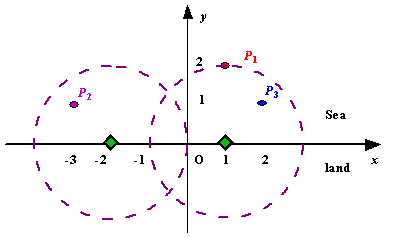Description
Assume the coasting is an infinite straight line. Land is in one side of coasting, sea in the other. Each small island is a point locating in the sea side. And any radar installation, locating on the coasting, can only cover d distance, so an island in the
sea can be covered by a radius installation, if the distance between them is at most d.
We use Cartesian coordinate system, defining the coasting is the x-axis. The sea side is above x-axis, and the land side below. Given the position of each island in the sea, and given the distance of the coverage of the radar installation, your task is to write a program to find the minimal number of radar installations to cover all the islands. Note that the position of an island is represented by its x-y coordinates.

Figure A Sample Input of Radar Installations
We use Cartesian coordinate system, defining the coasting is the x-axis. The sea side is above x-axis, and the land side below. Given the position of each island in the sea, and given the distance of the coverage of the radar installation, your task is to write a program to find the minimal number of radar installations to cover all the islands. Note that the position of an island is represented by its x-y coordinates.

Figure A Sample Input of Radar Installations
Input
The input consists of several test cases. The first line of each case contains two integers n (1<=n<=1000) and d, where n is the number of islands in the sea and d is the distance of coverage of the radar installation. This is followed by n lines each containing
two integers representing the coordinate of the position of each island. Then a blank line follows to separate the cases.
The input is terminated by a line containing pair of zeros
The input is terminated by a line containing pair of zeros
Output
For each test case output one line consisting of the test case number followed by the minimal number of radar installations needed. "-1" installation means no solution for that case.
Sample Input
3 2 1 2 -3 1 2 1 1 2 0 2 0 0
Sample Output
Case 1: 2Case 2: 1
首先考虑把坐标维度降下来再考虑贪心算法
#include<iostream> #include<cstdio> #include<cstring> #include<algorithm> #include<limits.h> #include<cmath> typedef long long LL; using namespace std; double d,x,y; struct node{ double l,r; }e[1010]; int cmp(node l1,node l2) { return l1.r<l2.r; } int main() { int n,flag; int cas=1; while(~scanf("%d%lf",&n,&d)) { if(n==0&&d==0) break; flag=1; for(int i=0;i<n;i++) { scanf("%lf%lf",&x,&y); if(!flag) continue; if(d<y) flag=0; double dis=sqrt(d*d-y*y); e[i].l=x-dis; e[i].r=x+dis; } printf("Case %d: ",cas++); if(!flag) { printf("-1 "); continue; } sort(e,e+n,cmp); int ans=1; double pos=e[0].r; for(int i=1;i<n;i++) { if(e[i].l>pos) { ans++; pos=e[i].r; } if(e[i].r<pos) pos=e[i].r; } printf("%d ",ans); } return 0; }